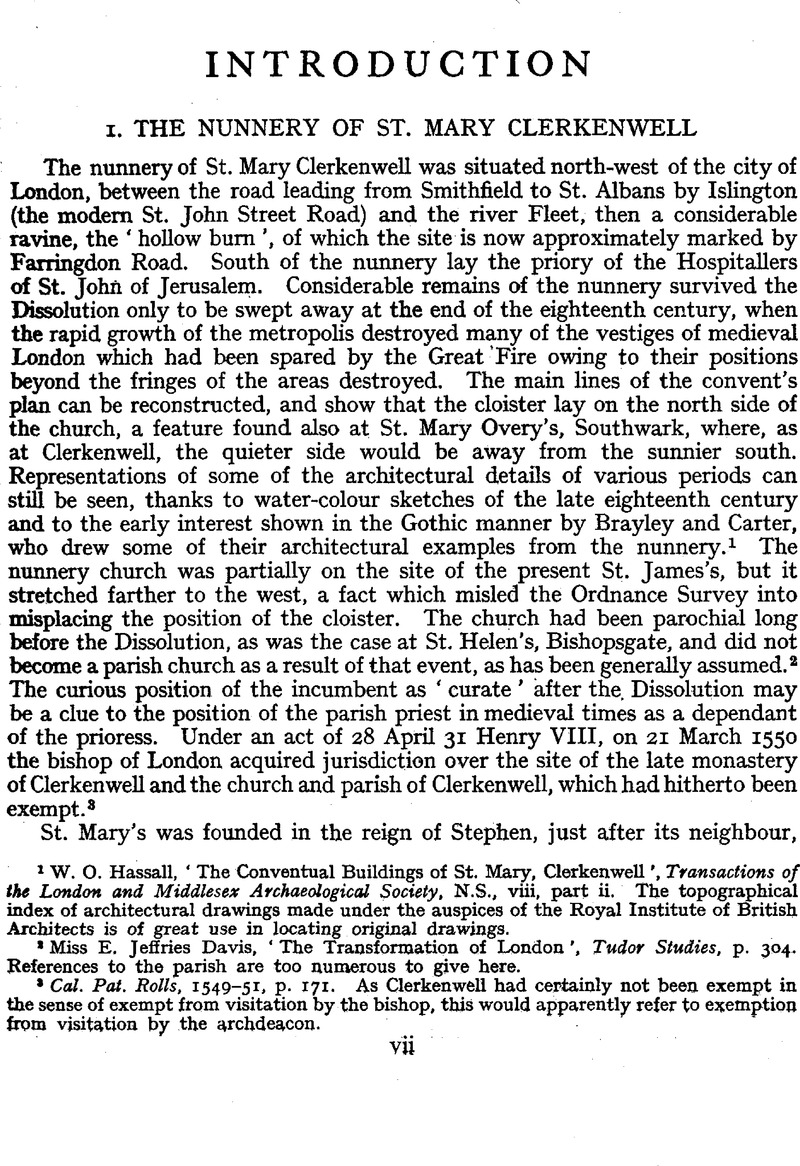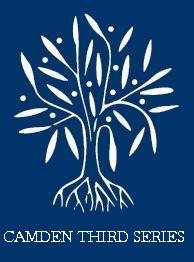No CrossRef data available.
Article contents
1. The Nunnery of St. Mary Clerkenwell
Published online by Cambridge University Press: 24 December 2009
Abstract

- Type
- Introduction
- Information
- Copyright
- Copyright © Royal Historical Society 1949
References
page vii note 1 W. O. Hassall, ‘ The Conventual Buildings of St. Mary, Clerkenwell’, Transactions of the London and Middlesex Archaeological Society, N.S., viii, part ii. The topographical index of architectural drawings made under the auspices of the Royal Institute of British Architects is of great use in locating original drawings.
page vii note 2 Miss E. Jeffries Davis, ‘ The Transformation of London ’, Tudor Studies, p. 304. References to the parish are too numerous to give here.
page vii note 3 Col. Pat. Rolls, 1549–51, p. 171. As Clerkenwell had certainly not been exempt in the sense of exempt from visitation by the bishop, this would apparently refer to exemption from visitation by the archdeacon.
page viii note 1 Round, J. H., ‘ The Foundation of the Priories of St. Mary and St. John, Clerkenwell ’, Archaeologia, lvi. 223–8Google Scholar, an article ignored by most subsequent writers in a way which much annoyed the author. Actually Tanner had already shown that Jordan de Briset could not have died as early as stated in the cartulary of St. John's; Notitia (1744), p. 299, note a.
page viii note 2 Hassall, W. O., ‘ The Family of Jordan de Briset ’, Genealogists' Magazine, ix, no. 15, p. 21Google Scholar.
page viii note 3 The nuns of Clerkenwell are called canonesses in the will of a minor canon of St. Paul's, Husting Roll, 122 (39). In Urban III's bull of 19 October 1186 they are Benedictine and in a bull of pope Nicholas V (1447–55), Lambeth MS., 644, 45. But in 1420 and 1424 they are ‘ ordinis sancti Augustini’, in Register of Chichele, i. 194 and 220.
page viii note 4 Hassall, W. O. ‘ Two bulls for St. Mary, Clerkenwell ’, Eng. Hist. Rev., lvii (1942), 97CrossRefGoogle Scholar. The bull was missed by Dr. W. Holtzmann in his Papsturkunden in England.
page ix note 1 No. 9.
page ix note 2 At the time of the cartulary they had property in eleven counties stretching over the country. The later evidence shows their property confined to five counties, all of which, except Dorset, are contiguous. This seems to indicate a deliberate rationalisation of the nuns' property.
page ix note 3 Pipe Roll Soc, xx, Pedes Finium, p. 101, no. 136.
page ix note 4 Bailiff's account, 1490–1, Ministers' accounts. Hen. VII, 396; prioress's accounts, 1524–5, 1525–6, 1527–8, 1532–3 and 1534–5; Ministers' accounts. Hen. VIII, 2115–2120; rental, probably 1535, Rentals and Surveys, portfolio 19/4; royal bailiff's account, 1539–40; Ministers' accounts, Hen. VIII, 2396; cf, ibid., 2395, 2428, 2380.
page x note 1 See P.C.C. wills, 33 Luffenam, 8 Blamyr, 10 Adeane, 5 Fetiplace, 2 Jankyn and 22 Dyngeley.
page x note 2 Cf. G. Kingsford's Stow, ii. 161.
page x note 3 ibid., ii. 161.
page x note 4 ibid., ii. 156, 158.
page x note 5 ii. 164.
page x note 6 i. 106, 214, 219; ii. 46, 165–7, 314.
page x note 7 i. 253; ii. 63, 328, 367.
page x note 8 i. 157; ii. 161–2, 336.
page x note 9 i. 245, 249, 336; ii. 165, 325–6, 385.
page x note 10 i. 275.
page x note 11 ii. 170.
page x note 12 i. 257, 270, 273, 288; ii. 5, 170, 172.
page x note 13 ii. 171.
page x note 14 i. 293, 300; ii. 174.
page x note 15 ii. 28.
page x note 16 ii. 85.
page x note 17 i. 275.
page x note 18 i. 222; ii: 170–2.
page x note 19 i. 195; ii. 170, 304.
page x note 20 For the long fight against lay encroachment, see my article on the Dorset properties referred to below, p. 284.
page xi note 1 Hassall, W. O., ‘ The Sussex property of St. Mary Clerkenwell and the Sackvilles, ’ Sussex Notes and Queries, xi. (1946), 38Google Scholar. For licences to alienate in mortmain, see Cal. of Pat. Rolls, 1301–7, 164; 1317–21, 192 and 520 (cf. Ancient Correspondence 36/201); 1324–7, 130; 1334–8, 544; 1399–1401, 293.
page xii note 1 Valor Ecclesiasticus, i. 405.
page xii note 2 Some of the grantees of the nunnery properties after the Dissolution are discussed by S. B. Liljegren in ‘ The Fall of the Monasteries and the Social Changes in England ’, Lunds Universitets Arrsshrift, N.F., I, xix, Nr. 10, pp. 45, 48, 49, 74, 78–9, 81, 83, 84–7, 90, 95, 97, 103, 107, 114, 118, where he cites grants of Clerkenwell property to Edmund Jarnyngham; Wm. Lock; Wm. Berners of Thoby, W. Farre and Wm. Glascok of London; Sir Thos. Pope, John Gates and J. Barwyke; Rob. Harrys; Rog. and Rob. Taverner; Ciriac Petytte; Chr. Campyon, London mercer, and John Rollesley; Roger Hyghame, London, and Wm. Grene, Lond. merchant tailor; Jn. Pope & Ant. Foster of Lond., Nic. Spakman & Chr. Harbotell, Lond. burghers; Wm. Goodyng; Rob. Curson and John Pope; Chr. Lytcote and Edw. Streitbury; Wm. Hodgis; Jas. Cofiyne and Th. Godwyn; Viscount Lisle; John Bellow and John Broxolme; Sir Rich. Rich; Walter Hindle.
page xii note 3 Miss M. Deanesley in Cambr. Med. Hist., v. 767.
page xii note 4 For the priest chambers see Trans. London and Middlesex Arch. Soc, N.S., viii. 253Google Scholar.
page xii note 5 Hassall, W. O., ‘ Plays at Clerkenwell ’, Modern Language Review, xxxiii. 564Google Scholar.
page xiii note 1 Hassall, W. O., ‘ The Essex property of the Nunnery of St. Mary Clerkenwell’, Trans. Essex Arch. Soc., N.S., xxiii. 17Google Scholar.
page xiii note 2 Riley, Memorials of London, p, 320.
page xiii note 3 British Magazine, xxxi. 544–5.
page xiii note 4 For Boniface's composition and Kilwardby's modification thereof, see Wharton, De episcopis et decants Londinensibus et Assauensibus, (1695), pp. 259, 261; Wilkins, Concilia, i. 758–9; Churchill, I., Canterbury Administration, i. 172; ii. 49, 52Google Scholar.
page xiii note 5 Canterbury and York Soc, i. 35.
page xiii note 6 Clerical Subsidy Roll 42/4.
page xiii note 7 Letters and Papers, xv. 546 (Augm. bk., 234, fo. 56V); Monasticon, iv. 78; Pinks, History of Clerkenwell, p. 29.
page xiv note 1 Letters and Papers, xx, pt. ii, p. 412, 850 (19).
page xiv note 2 E. Power, Medieval English Nunneries, pp. 12–13.
page xiv note 3 Sharpe, Wills, i. 585; Husting Rolls, 53 (105), 89 (180), 111 (159), 119 (20); P.C.C. wills, 5 Fetiplace, 8 Blamyr.
page xiv note 4 Sharpe, Wills, i. 313, 501, 701; Husting will, 74 (173); Williams, Early Holborn, i. 66; P.C.C. wills, 33 Luffenam, 10 Adeane, 5 Fetiplace, 22 Dyngeley.
page xiv note 5 H. Cole, Documents illustrative of English History in the 13th and 14th centuries, selected from the Records of the dept. of the Queen's Remembrances, p. 215.
page xiv note 6 In 1318 Archbishop Melton laid down, that at Nun Appleton not more than two or three nuns from one family were to be admitted into the house without special licence for fear of discord arising.
page xiv note 7 Ministers' accounts. Hen. VII. 396.
page xiv note 8 The miracles which brought the oblations are mentioned in bulls of 4 May 1476 and 6 March 1478. See W. McB. Marcham in Trans. London and Middlesex Arch. Soc., N.S., vii. 611–18. But see Pinks, History of Clerkenwell, p. 19, for a priest's slanders.
page xiv note 9 The accounts for 1524–5 and 1526–7 show this was done by Katharine Smyth. In 1532–3 and 1534–5 the work was done by Joanna Fermour.
page xv note 1 Margaret Bulle, ‘ nuper thesauraria ’, Account Roll for 1490–1.
page xv note 2 Cecilia, mid-thirteenth century, no. 333. Katherine Marten, late sub-prioress, 1524–5, see account roll for 1524–5.
page xv note 3 Document BB and Appendix 4.
page xv note 4 P.C.C. wills, 29 Lyon. G. Baskerville (in Essays in History presented to R. L. Poole, p. 461) quotes another.
page xv note 5 Mr. W. McB. Marcham kindly referred me to De Banco Roll, Easter, 17 Ed. I, no. 78, mem. 96d.
page xv note 6 For a twelfth-century boarder, an heiress whom William Longchamp chose as bride for his brother, see MissConway, A. E., in Archaeologia Cantiana, xxix, especially 17–18Google Scholar.
page xv note 7 For earlier residents see E. Power, Medieval English Nunneries, p. 259, citing Sharpe, Wills, i. 324; Williams', Early Holborn, no. 1128, citing Faustina B. viii, fo. 162V. and 1064; Genealogist, N.S., xxxv. 121, calendaring Lambeth wills, 117 Langham; Cal. of Close Rolls, 1364–8, p. 261; Tomlins, Perambulation of Islington, p. 52 note; Sharpe, Wills, xsii. 47; P.C.C. wills, 2 Jankyn.


